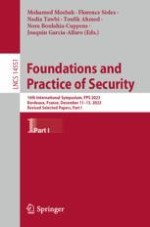2024 | OriginalPaper | Buchkapitel
On Exploiting Symbolic Execution to Improve the Analysis of RAT Samples with angr
verfasst von : Serena Lucca, Christophe Crochet, Charles-Henry Bertrand Van Ouytsel, Axel Legay
Erschienen in: Foundations and Practice of Security
Verlag: Springer Nature Switzerland
Aktivieren Sie unsere intelligente Suche, um passende Fachinhalte oder Patente zu finden.
Wählen Sie Textabschnitte aus um mit Künstlicher Intelligenz passenden Patente zu finden. powered by
Markieren Sie Textabschnitte, um KI-gestützt weitere passende Inhalte zu finden. powered by
